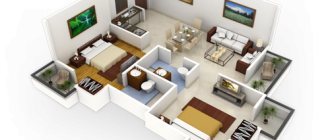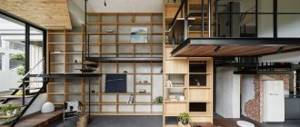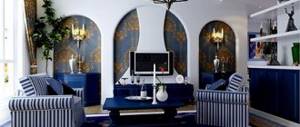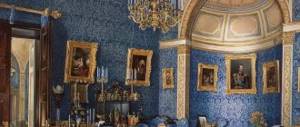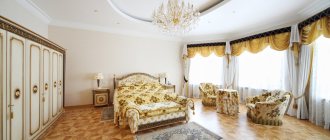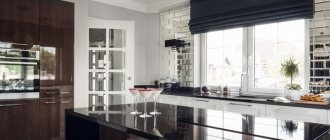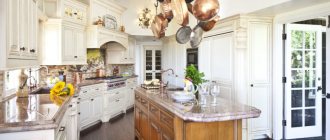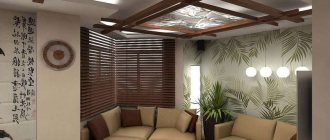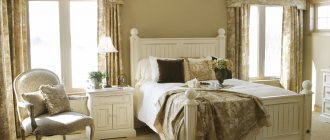Tile in the loft - the best solution for your budget and advice on choosing for the floor, bathroom and kitchen
ReLend.ru » Styles » Tiles in the loft - the optimal solution for your budget and advice on choosing for the floor, bathroom and kitchen
You are finishing a new apartment, or you have decided to radically change the style of your home. Perhaps the loft style (from the English loft - attic) will suit you. It actively uses tiles that imitate concrete, brick, asphalt and other materials typical for the interiors of attics, warehouses and industrial premises.
Contents of the article [hide show]
Reference . The style originated in America in the mid-20th century. If for Western countries it is quite familiar (although it does not lose its relevance), then in Russia it is only gaining popularity.
In the interior photos below, you can see how harmoniously the tiles fit into the loft style. As you can see, despite the apparent asceticism, rooms decorated within this style can be very beautiful and cozy.
Loft style kitchen furniture
Furniture is an integral part of the kitchen interior, so its choice should be given special attention. Those who want to decorate their kitchen in a loft style in an apartment often prefer white.
A bright loft-style kitchen looks spacious and stylish. It is worth noting that furniture in this direction does not necessarily have to outlive several generations of its users; it may well be modern. The “patina of old age” in this case can be embodied in other details. For example, it could be a brick wall with laconic wooden shelves, which will go perfectly with a modern set.
Wood, glass and metal are most often used to make kitchen furniture in the loft style. So, a glass table will make the interior of your kitchen lighter and airier.
As an addition to it, you can purchase chairs with metal frames. It would be good if the base of the table was also made of metal. You can place soft pillows on the seats of the chairs to make the dining area more comfortable.
A loft-style kitchen set, as a rule, has one tier. Upper cabinets are replaced with open shelves, which serve more of a decorative function. Therefore, you should not place a lot of small accessories on them; it is better to leave the shelves half empty - open ones look especially advantageous in small kitchens. Wood is usually used as a material for shelves.
The most suitable design option is artificial aging. These may be shelves painted with light paint and with scuffs. The walls of a small kitchen can be decorated with glass shelves, and original forged items can be placed as elegant accents.
Let's look at some pieces of furniture for a loft-style kitchen.
1.Kitchen set.
A kitchen set in a loft style can be either straight or corner. If necessary, you can also buy a loft-style kitchen, custom-made taking into account all the features of your layout.
The surfaces of the set can be made of rough-hewn wood, painted in neutral shades or covered with a metal-effect laminate film. Sets finished with stone veneer, which is a 1 mm thick cut of rock and looks like real rock, look very original.
2.Dinner Zone.
The eating area in a loft kitchen is usually equipped with furniture that looks simple and concise. Chairs with thin metal legs, a wooden, metal or glass table with parallelepiped stands are suitable here.
When choosing a table, you need to pay special attention - it should look stylish and expensive. Most often in loft-style kitchen-dining rooms you can see wooden tables. This could be expensive wood or “aged” rough boards.
The location of the table can be very different. It can be placed against the wall or in the center of the kitchen, and it can be an independent element of the interior or a continuation of the kitchen unit. And some owners of large apartments even prefer to arrange a dining area outside the kitchen.
The size of the table should depend on your needs and available space. It can be either a massive piece of furniture for ten people or a compact transforming table.
The table top for a loft interior can be made in a variety of shapes: square, rectangle, oval, circle or semicircle. Pay attention to the stone countertop – it looks original and unusual. The surface made of natural wood is not inferior to it - it is a classic that looks expensive and stylish.
The most budget-friendly options are countertops made of MDF and chipboard, but they must be decorated in a manner appropriate to the loft style (and, of course, are very inferior in quality to natural wood). The glass table is a more modern, but no less suitable model.
It’s good if the color of the table is contrasting - this will highlight the dining area.
3.Storage systems.
In loft-style kitchens, unlike other interiors, the use of open shelves, racks and hooks is allowed. The convenience of this solution is that you can immediately find the item you need.
If you have a small space at your disposal, it is better to hide all the dishes behind the cabinet doors and, as already mentioned, leave the open shelves half empty. The number and names of storage systems should be chosen personally by the kitchen owner, because who else but her knows how many things and objects will have to be placed in the kitchen space. Household appliances can be left in plain sight, but it is advisable that they all be made in the same style.
4.Fridge.
If your kitchen lacks a bright accent, you can safely place a retro refrigerator in red with rounded corners. And if you prefer calmer colors, opt for one of the modern models in a classic steel shade.
Kitchen design in loft style (photo):
Floor
For the floor, materials that imitate concrete or metal are often chosen. An excellent choice is graphite tiles, which resemble asphalt in appearance. A universal solution for both walls and floors is tiles that look like aged brick. Currently, leading manufacturers of facing ceramics create them using casts from authentic ancient masonry. A wonderful option for the floor is an imitation of aged hexagonal brick.
Important ! Remember contrasts. If the floor is finished in brick, which is usually distinguished by rich, warm shades, then the walls can be decorated in cool, light colors like concrete or metal.
For Bath
Style implies an abundance of space and light. It is difficult to meet these requirements for a bathroom, but the right choice of materials will compensate for the small area and lack of lighting.
Ceramic
The high moisture resistance of ceramics makes it an excellent material for bathrooms. When decorating a loft-style bathroom, choose black, white or gray colors. Remember that white walls visually enlarge the room and are preferable for small bathrooms.
Aged
Aged (vintage) tiles in light colors with imitation of rust, mold and other signs of venerable age look good in the bathroom The surface can be textured or smooth.
Under the brick
Brickwork is one of the main solutions for loft-style walls. As mentioned above, a room with white walls seems more spacious, so imitation white brick is preferable for a bathtub.
Loft Style
The LB-Ceramics company produces the “ Loft style ” collection for decorating bathrooms. Made in gray and white tones, it successfully combines geometric patterns and floral motifs.
This video provides a review of the “Loft style” stone imitation tile.
Loft style kitchen color
Color design is one of the main characteristic features of the loft style. To decorate loft interiors, neutral shades are most often chosen and diluted with textures characteristic of the industrial direction: rust, red brick, wood.
1.White kitchen in loft style.
The snow-white interior always looks fresh and neat. This color will look great on kitchen facades, work surfaces, and dining furniture.
The walls in loft kitchens can be decorated with sand-lime bricks and whitewashed on top. The ceiling in a loft-style kitchen is often painted snow-white, as this allows you to visually increase the height of the room. If you have a small kitchen space, then it also makes sense to choose light shades when purchasing flooring materials.
2.Gray kitchen in loft style.
Metal is considered one of the most typical materials of an industrial interior; therefore, when decorating a modern kitchen in the loft style, you can use any shades of gray. In a loft, you can choose gray as the main color or mix it with other neutral tones in any proportions.
3.Black kitchen.
If in classic interiors black should be used with great care, in a loft you can practically not limit yourself to finishing the kitchen with a charcoal shade. Black looks especially good in spacious kitchens. You can give preference to dark walls, floors, ceilings, or choose black appliances, furniture or accessories.
4.Wood color.
To furnish loft premises, wood of various species and textures is often used: aged furniture, ceiling beams and even plank floors. Matte surfaces of the furniture or other details with a wood cut pattern will make the cold industrial interior of the kitchen warmer and more comfortable.
5.Brown kitchen.
Ocher-brown, or the color of brick, can highlight the loft decor in your kitchen. Use modern finishing materials to imitate brickwork, or simply maintain the original look of brick walls in your kitchen space.
For kitchen
Whatever style of kitchen design you choose, the materials must have the following qualities:
- safety;
- aesthetics;
- resistance to cleaning and washing (especially for the “apron” - the walls above the stove, work surfaces and sink).
Ceramic tiles from trusted manufacturers meet all these requirements. If you decide to decorate your kitchen in a loft style, pay attention to the following options.
Jade ceramics
Collection "Loft" from. Imitation of wet concrete with patchwork style elements. Features geometric patterns, floral designs and funny scenes.
Azori (Azori) on the apron
Collection "Loft" from for covering the apron. Light aged tiles combine effectively with wildflower motifs.
Important! The smaller the kitchen area, the lighter the facing materials should be.
How to decorate a small kitchen or kitchen-living room in a loft style, as well as about color combinations for the kitchen, read in our separate articles.
Loft style in the interior of an apartment: modern design with ceramic tiles
Loft style interior is a haven for the young and daring. It is for those who are completely devoid of any prejudices and are ready for experiments.
Photo by Aaron Huber on Unsplash
This style appeared thanks to the industrial crisis in the United States. Abandoned factory buildings located in city centers were sold at bargain prices as businesses closed en masse. New owners often did not have sufficient funds to decorate the premises, so the interiors could be decorated with whatever they could find - be it a chandelier made from old dishes or an antique table that needed restoration.
Quite often, such buildings were occupied by people from the creative bohemia, like Andy Warhol’s famous loft, so the style is characterized by both freshness and creativity.
Photo by Brandon Cormier on Unsplash
Characteristic features of the Loft style
Literally, this word means “attic.” Such premises were born from manufactories, factories, warehouses and attics. The key paradigm of this style is a certain roughness and preservation of industrial aesthetics. Other features include:
- Large spaces without partitions with high ceilings, not typical for ordinary residential apartments. No doors or locks!
- Exposed structural and engineering elements: beams, pipes, metal columns, stairs, electrical wiring.
- Emphasis on natural light and minimal window decoration. There should be a lot of windows, they should be large, arranged in a characteristic small layout. As a last resort, simple metal blinds are used.
Photo by Nathan Van Egmond on Unsplash
- Use of technical decor. An old bicycle on the wall, metal lamps or furniture welded from steel scraps from machinery.
- The use of finishing materials such as brick, rough wood, bare concrete.
Ceramic tile
The style is based on large spaces and their proper zoning. Therefore, it is quite convenient to highlight certain areas using ceramic tiles.
The Brixtory porcelain tile collection is perfect for decorating a creative interior. Thanks to the “aged” basic “brick” tiles and the daring decorative panel in the form of graffiti, it fits perfectly into the overall concept of the style. Brixtory is well suited for finishing walls and floors in the kitchen, living room and bathroom.
An alternative option is the Carrara Marble and Loft collection. These are plain or patterned tiles in different shades of gray, which visually combine with open utility networks, metal elements and other characteristic features of the urban style. Interesting and trendy solutions in the new decor with gold veins in concrete will add simplicity and chic to the Loft space.
Loft is a territory devoid of any prejudices and clichés. There are no standards here, you set the rules here, so tear down the walls, use unexpected colors, search, find and dare!
Economical options
If you have limited funds, you can resort to budget options.
Decorative gypsum loft brick
The Loft Brick collection, produced by Monte Alba. The material imitates antique brickwork. Easily attaches to any wall.
Imitation brickwork
Having some finishing skills, you can independently create a wall texture that in appearance will hardly differ from real brickwork . The wall is primed, narrow masking tape is glued to it, marking the “brick” pattern. Loose ends of tape are left along the edges of the wall. Then plaster is applied. You can use a spatula, but when laying by hand it is very convenient to use your fingers to create patterns similar to the natural irregularities and cracks of brick.
After 2-5 minutes (depending on how thickly the plaster is diluted), the tape is removed, and in its place there remain stripes resembling seams between bricks. To ensure that the edges of the “bricks” are even, it is very important not to overexpose the plaster.
Important! Before starting work, the floor should be covered with newspapers or other materials so as not to stain it with plaster.
This video shows 5 ways to apply brick decor.
In Scandinavian kitchen style
Interiors featuring the Scandinavian style are always distinguished by their special functionality and maximum convenience. Therefore, for the kitchen and apron, this option is considered not only modern, but also creative. The main design features have virtually no restrictions in terms of the choice of palettes, combine design elements in different ways and are oriented towards minimalism. Among the important features of this style are the following requirements:
- natural materials (wood, stone, ceramics, glass, metal);
- a large amount of light (mostly natural, not lamps);
- brevity and comfort, absence of overly decorative details;
- both a white background and bright details (preferably evenly);
If you focus on the classic variations of an apron in a Scandinavian-style kitchen, then you can take the following schemes as a basis :
- White or very light shade. Usually these are boar tiles with and without chamfers, cream mosaics, brick imitation or wall panels made of tempered white glass.
- Bright or accent decor. For this option, it's common to choose bold patterned tiles (the handmade cement version), fine rainbow mosaics, 10x10 tiles, or photo-printed tempered glass. The most popular colors for a contrasting apron are gray, wet asphalt tone, red and blue (or its subtones - ultramarine, turquoise, blue).
- visual expansion of space, which is great for small spaces;
- originality, novelty and modernism in the design of the work area;
- ease of cleaning and resistance to detergents.
Unfortunately, this interior also has disadvantages. The main disadvantage of such a palette comes down to the complexity of cladding - such a format should only be trusted by experienced craftsmen in order to achieve a good result.
- does not have versatility in combination with interiors;
- gets dirty quickly and requires frequent washing;
- Scratches often appear on popular materials;
- is expensive, and the service itself is considered an individual project.
Features of introducing the loft style into the kitchen interior
Color scheme and materials
The combination of rough finishing materials (raw wood, concrete, plaster, brickwork, stone) with household elements makes the room more lively.
There are no strict requirements for choosing a color. But, as a rule, the decoration contains basic, natural tones (black, gray, white, brown) due to the specifics of the materials, and bright colors (yellow, red, blue) are used in accessories and furniture.
- A black kitchen
is an idea for rooms with good natural light.
- Blue kitchen
in a mixed style: loft, classic, modern.
- A gray kitchen
should be diluted with bright details and have warm artificial lighting.
The brickwork, ranging from light brown to deep orange, is the most recognizable feature of the style. It is in the loft that it is used most often.
Brickwork in gray or even white is an excellent option for a small room or with windows facing south.
White brick in the interior with loft and Scandinavian elements
Brickwork can be done with your own hands. And to reduce the cost of the process, make an imitation of it. How to do this finishing yourself at minimal cost, watch the video:
For the floor, parquet boards or laminate with a natural wood pattern, tiles are suitable.
It is not customary to use wallpaper in this design. The walls are usually plastered.
The ceiling can be painted with water-based paint in a neutral white color. Another hallmark of the style will be the fastening of wooden beams and metal profiles. Spotlight chandeliers are also attached to them.
Kitchen set
- The main piece of furniture in the kitchen is the set; against the backdrop of restrained walls it can be in rich colors.
- The color of the facades of the upper and lower tiers may vary.
- Also noteworthy in this design is the absence of mezzanines at all. Instead, you can build shelves.
- The facades of the set can be classic or modern, which does not violate the general idea.
Apron
To finish the apron area, you can choose:
- “hog” tile;
- MDF panels, chipboard;
- glass;
- ceramic tiles;
- brickwork treated with water-repellent agents;
- fake diamond.
Dinner Zone
A table made of solid wood with soft chairs with a high back will look great in a spacious kitchen. The carriage screed, which is familiar to us as a frequent element of classic and sophisticated interiors, goes well with industrial motifs.
To organize the dining area, bar stools with chrome legs, plastic stools, and leather chairs are often used.
Kitchen-dining room
Decor, lighting
Active decoration and the presence of a large number of bright details are distinctive features.
Here it is appropriate to abandon curtains altogether, especially if the house has large panoramic windows. You can use thick floor-length curtains or curtains made of natural fabric, Roman or roller blinds, or blinds.
Futuristic paintings, banners, posters, photographs in unusual frames, forged items, glass holders, and candlesticks can be used as decorations.
Bright pillowcases with geometric patterns and prints will complement the industrial atmosphere.
To organize lighting, use pendant lamps reminiscent of industrial lamps or street lamps. Now in the store you can find chandeliers in the form of an ordinary light bulb suspended on a long wire from the ceiling.
Country
Unlike classic design with its perfectly flat and smooth surfaces, Country style requires deliberate roughness and negligence. There are three traditional methods of finishing aprons:
- sloppy plaster followed by whitewashing or painting with water-based paint (must have specially left drips and other defects);
- visible brickwork (bare walls left unplastered, topped with translucent water-based paint or plastic panels);
- wood finishing (here the choice of materials is quite wide: natural boards, lining, panels, veneer, slats, always coated with moisture-repellent coatings and varnish).
In order to replicate the warm Country style as closely as possible, you must strictly follow the following rules: choose discreet, non-screaming and natural colors, install open shelves, use antique household and decorative elements, connect the use of wood carvings to the decor and disguise modern household appliances.
- small-format tiles 10x10 (white, cream, light and dark beige, terracotta, brown, majolica or blue glazed tiles);
- ceramic panel behind the stove;
- hog tiles with a glossy or matte surface;
- decorative brick or its clinker version;
- handmade with ethno design or its factory imitation.
And as the complete opposite of a calm tone, an alternative in the form of bright glazed tiles with a smooth or wavy surface is suitable.
- resistance to water, chemicals, temperature changes;
- high strength of the material and its fire resistance (with proper processing);
- a huge number of palettes and thematic collections.
The only disadvantage of tiles is the fact that it is quite difficult to install in order to maintain a natural look - the main highlight of the style in question. To do this with your own hands, such a design will be difficult and time-consuming, and among professional craftsmen, not everyone knows how to work with such a unique material. Therefore, for an apron it is important not only to stock up on a high-quality base, but also to find an experienced performer.
Loft style tiles: modern interior design
The loft style continues to gain popularity both abroad and among domestic designers and users. It attracts with its simplicity of details, interesting decor, affordable materials and versatility, since there are no restrictions on its use. Loft is suitable for any room, regardless of the size of the room, which makes this style direction the most relevant and simple in the world of design.
Characteristic features of the Loft style
Over the many years of its existence, development and adaptation to different needs, the loft style has managed to grow into many other interior design styles and acquire many different forms. Despite this, the basis of the loft style always remains unshakable and strict. And all the key characteristics of the main style of our time can be reduced to 6 basic rules.
Let's figure out what the loft style is in its purest form.
Open spaces
One of the main characteristics of the loft style, which has also become one of the main features of modern interiors in general, is an open layout and large, maximally spacious spaces. Inheriting the aesthetics of empty old plants and factories, the loft style does not tolerate walls or even partitions - everything in it is one large space, everything in it is one.
The necessary zoning of the interior in the loft style is achieved through finishing and interior design. The most common forms of zoning are the use of color contrasts in the decoration of the room, light accentuation of zones, and the use of glass or hollow partitions that do not interfere with the feeling of spaciousness.
Industrial features of the interior
Perhaps one of the most important and most recognizable features of the loft style is the interior design with rough, deliberately industrial details and elements. Wall decoration with aged brickwork, concrete or plaster, exposed pipes, open ventilation systems, rusty metal - all these are integral and recognizable features of the loft style.
Probably the most popular feature of a loft style interior is the stark brick wall with obvious signs of wear and age. Fortunately, in order to achieve the desired effect, today there is absolutely no need to tear off the wallpaper, expose the walls and lament that the house turned out to be not brick at all. Modern finishing methods, for example, brick-look ceramic tiles
or decorative masonry, offer an extremely authentic visual imitation of the original material, while maintaining practicality, reliability and ease of maintenance.
Combining old and new in the interior
Another important feature of interior design in the loft style is the endless contrast between deliberately old and ultra-modern interior details. Worn brick walls and metal pipes with traces of rust create a stark contrast with modern appliances, chrome surfaces, fashion accessories, metallic tiles and so on.
Loft style furniture
The loft style is not just open space and wall cladding, but also all the furniture and all the accessories included in the interior.
Furniture for a loft-style interior is selected either in an antique style, or, on the contrary, in a minimalist or hi-tech style. As a rule, a loft knows how to masterfully combine furniture of different styles, achieving a stunning effect of harmonious eclecticism.
Furniture in a loft interior not only serves its functional and aesthetic purpose, it also represents an effective zoning tool. For example, a countertop will allow you to separate the kitchen area from the living room, and a properly placed sofa will highlight a relaxation area - this is a great way to divide the interior without erecting walls.
High and light ceilings
High and light ceilings are also a characteristic feature of the loft style, inherited from old factory premises. Unfortunately, it is not always possible to simply “raise” the ceilings, especially in the context of small domestic apartments. In this case, it is necessary to resort to a variety of design tricks - for example, decorating the ceiling in light colors, proper use of lighting, or tiling the interior with vertically laid tiles allows you to visually raise the ceilings of the room.
Accessories
The loft style compensates for the lack of walls and partitions with an abundance of bold accessories. Graffiti, posters, abstract paintings and sculptures, even road signs and other elements of city life will complete the interior decoration in an industrial style and give it a characteristic aura.
Peculiarities
A loft cannot be called an interior that will suit every person, since some will lack comfort, warmth and completeness in the design.
Textured surfaces are one of the main components of style, which must certainly be present in interior design. Brickwork, outdated plaster, uneven surfaces of the walls and imitation of industrial and natural materials are just a small part of the textures that can be used when decorating a room in the loft style.
A special place in the design of this plan is occupied by the choice of tiles. The process of selecting materials cannot be called easy, because each texture complements the interior in its own way and can decorate the room or reveal all its shortcomings.
Kitchen-living room in loft style
The advantages of combining a kitchen space with a living room include the following:
- The absence of walls allows you to significantly expand the living space. Such an apartment has more space, which means more opportunities for implementing various design ideas.
- A room without interior partitions allows you to simultaneously cook and watch your favorite movie on a TV located in the living room or, for example, keep an eye on children playing.
Kitchen-living room in loft style (photo):
Negative aspects of the common space of the kitchen and living room are:
- Lack of hood, which can lead to damage to furniture surfaces.
- The previous reason may result from the spread of unpleasant odors throughout the apartment. It’s good if it’s the pleasant aromas of baking, but the smell of fried fish or burnt food will definitely make you want to run away.
- You will have to not only carefully select finishing materials, but also ensure that all accessories (dishes, textiles, etc.) correspond to the same style.
- If some emergency occurs in the kitchen (a pipe bursts or something catches fire), the interior of the living room may also suffer.
Please note that if the kitchen and living room are combined, both spaces should be decorated in the same direction, in our case, in the loft style. This applies to surface finishing, furniture, and various accessories.
In kitchen appliances, it is quite acceptable to use items from “different” eras. This will only add originality to your interior. For example, you can place a modern coffee machine and a Soviet-era gas stove in the same kitchen.
When finishing the floor in the kitchen-living room, it is better to opt for a plain covering made of tiles, porcelain stoneware or wood. If you prefer to lay the floors with tiles, then it is recommended to choose dark colors with an aged effect. In some cases, the flooring in loft rooms is finished using self-leveling coating or linoleum.
For small kitchens, it is recommended to choose glossy floor coverings in light colors.
The walls in a combined space can be decorated at your discretion using modern finishing materials (veneer, tiles, etc.), the main thing is that they blend organically with the furniture and do not contradict the general concept of the industrial style.
In the kitchen-living room it is also not prohibited to use chalk paint to decorate one of the walls. We have already discussed all the features and advantages of this coating earlier, but we would like to emphasize once again that such an interior will look stylish and unusual.
The problem of the lack of interior partitions can be partially solved by placing a glass partition with metal parts, a decorative screen or a bookcase. This way you can smooth out some of the shortcomings in the design of the rooms (for example, accessories and small details that do not correspond to the loft style will not be so obvious).
As conceptual accents of the loft-style kitchen-living room interior, you can install a retro telephone or a bar counter with elite alcohol and stylish wine glasses. Please note that the listed items used in arranging loft spaces perform not only a decorative, but also a practical function.
Types of materials
The main types of raw materials used to create the loft style are as follows:
- Industrial textures are a classic for this style, since the loft got its start from the design of abandoned and unnecessary premises: warehouses, factories and large factories. Initially, they were converted into office buildings and various workshops, and after that they began to be used as residential premises. New types of tiles are constantly appearing on the building materials market, which completely imitate industrial materials and allow you to create unique designs for various types of premises.
It is almost impossible to distinguish an authentic texture from a high-quality imitation with the naked eye. Only top-level professionals can do this. At the same time, the cost of such materials is much lower, and ease of use makes it possible to install them in any part of the room without unnecessary difficulties.
- A symbolic texture for the loft style is the presence of a brick wall protruding in different colors. The most current color palette is the typical red color for brick, but it can be quite successfully replaced by white, gray, beige, brown and black, depending on the requirements of the project. The masonry looks beautiful and stylish, but it will be very difficult to care for such a surface, because dust and dirt often accumulate on it, especially if light-colored tiles are chosen. You can only remove it with a dry cloth or a special brush, but this is a rather complex and time-consuming process. In addition, only an experienced specialist who has performed such work more than once and is familiar with the installation features can install the material.
- Metal surfaces are actively used in the design of loft-style rooms, but they must be used in small quantities. It can be gold, silver, brass, copper and bronze. The basis of the material is porcelain stoneware, but it is in no way inferior in external qualities to real metal surfaces. The use of metals is relevant in technical rooms, where you need to add a little brutal and hard design to the interior.
- Concrete is an excellent material that acts as a backdrop for future designs. Tiles that imitate a concrete surface not only replicate all the external manifestations of this material, but also surpass it in terms of ease of use. Designers advise using concrete tiles to decorate the floor.
- Plaster-style tiles are one of the most popular types of finishing for the loft style. It can act both as a bright accent and to create a neutral zone that will not distract attention to itself.
Natural materials have long earned the love of designers when decorating rooms in various styles. It is beautiful, practical and environmentally friendly, but high-quality wood, natural stone or leather are very expensive, so tiles come to the rescue, which completely replicate the appearance of natural textures and have a lower cost. The most popular options are:
- Wooden surfaces are on par with brickwork, if we talk about the main components of the style. They fit completely into the interior, adding light and warmth, slightly compensating for the lack of comfort and smoothing out clear and hard boundaries. Tiles, unlike natural wood, can be used not only in residential premises, but also in rooms with high humidity. It completely replicates the wood finish with various cracks, characteristic abrasions and a special pattern.
- No less important is the use of imitation natural stone. Quartzite and sandstone are easily combined with other materials, both industrial and natural.
Kitchen lighting in loft style
The main role in the kitchen and in any loft-style room is given to natural light (for this it is recommended to choose a room with large panoramic windows). But you can’t do without artificial lighting sources either.
The appearance of the light sources should also fit into the surrounding interior. The most successful option is bright lamps hung around the entire perimeter of the kitchen.
Moreover, it is not at all necessary to select shades for such lamps, or you can use the most ordinary metal lampshades that cover only the upper part of the light source.
An impressively sized crystal chandelier located in the center, right above the dining table, will look unusual in a loft interior.
You can ensure the required level of visibility in the working area of the kitchen space using contour lighting. Pendant lamps will help you with this; they also highlight the height of the room well.
Popular options for illuminating desired areas in the kitchen also include spotlights and spotlights.
Place light sources in such a way that the kitchen area is equally light not only during the day, but also at night.
But try not to overdo it, otherwise your kitchen will resemble a cold factory floor. To avoid this effect, try adding a little warmth and softness to your lighting.
